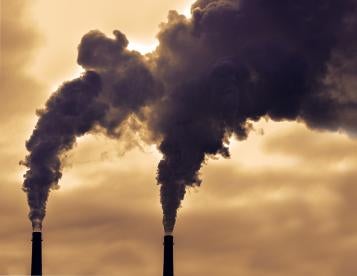The Treasury Department and IRS have issued long-awaited Proposed Regulations regarding the tax credit for carbon capture and sequestration under Section 45Q of the Code1 (the “section 45Q credit”).
Generally, the amount of the section 45Q credit and the party that is eligible to claim the credit depend on whether the taxpayer captures qualified carbon oxide using carbon capture equipment originally placed in service at a qualified facility before February 9, 2018 (“Old 45Q Facility”), or on or after February 9, 2018 (“New 45Q Facility”), and whether the taxpayer disposes of the qualified carbon oxide in geological storage (“sequestration”), uses it as a tertiary injectant in a qualified enhanced oil or natural gas recovery project (“EOR”), or utilizes the carbon oxide in certain specified ways (“utilization”). The effective date of the amendments to the Code extending and expanding the section 45Q credit is February 9, 2018 (the “Credit Effective Date”). The Credit Effective Date appears throughout the Proposed Regulations to distinguish between Old 45Q Facilities and New 45Q Facilities and establishing the effective date for certain provisions.
In the case of carbon oxide captured using carbon capture equipment that is originally placed in service at a qualified facility on or after the Credit Effective Date, the section 45Q credit is available during the 12- year period beginning on the date the equipment is originally placed in service.
Treasury and the IRS have previously issued Notice 2020-12, providing guidance on when construction has begun on a qualified facility or on carbon capture equipment that may be eligible for the carbon capture credit, and Revenue Procedure 2020-12, creating a safe harbor for carbon capture partnerships formed to invest in projects qualifying for the section 45Q credit. Our prior client alert discussing that guidance can be accessed here. The Proposed Regulations provide additional clarification on various definitions, including qualified carbon oxide, industrial facilities and carbon capture equipment, how secure geological storage is determined for both sequestration and EOR, who the credit is attributable to, the election to transfer the credit to a third-party that sequesters or uses the carbon oxide, and rules for credit recapture.
Proposed Regulations and Effect. The Proposed Regulations are subject to a comment period and a potential hearing before they are issued in final form. Taxpayers will have 60 days from the date of publication in the Federal Register to submit comments and a request for a hearing. (The Proposed Regulations have been released to the public, but will not officially be published in the Federal Register for approximately another two weeks after the date of this client alert.) The Proposed Regulations provide that when adopted in final form taxpayers may rely on and choose to apply the regulations for taxable years beginning on or after the Credit Effective Date, provided the taxpayer applies the rules in their entirety and in a consistent manner.
Credit is Attributable to the Owner of Carbon Capture Equipment. In the case of qualified carbon oxide captured using carbon capture equipment that is originally placed in service at a qualified facility on or after the Credit Effective Date, the section 45Q credit is attributable tothe person that owns the carbon capture equipment and physically or contractually ensures the capture and disposal, injection, or utilization of such qualified carbon oxide. The taxpayer does not need to own the industrial facility that emits the carbon oxide that is captured by the carbon capture equipment.
Contracts to Ensure Capture and Disposal. The Proposed Regulations provide a framework for the types of contracts, terms, and reporting requirements that will demonstrate the contractual assurance of the capture and disposal, injection, or utilization of qualified carbon oxide. The Proposed Regulations provide that a taxpayer may enter into multiple contracts with multiple parties for the disposal, injection, or utilization of qualified carbon oxide. For example, a taxpayer who captures qualified carbon oxide may contract with one party to dispose of a portion of its captured qualified carbon oxide through sequestration and with another party to use a portion of its captured qualified carbon oxide as a tertiary injectant for EOR. The existence of each contract and the parties involved must be reported to the IRS on an annual basis.
The Proposed Regulations require taxpayers contractually to ensure the disposal, injection, or utilization of qualified carbon oxide in a binding written contract that includes commercially reasonable terms that provides for enforcement. The Proposed Regulations provide that taxpayers may include information regarding how much carbon oxide the parties agree to dispose of, inject, or utilize in their contracts. Contracts also may include various other specific provisions relating to enforcement, such as long-term liability provisions, indemnity provisions, or penalties for breach of contract or liquidated damages.
The Proposed Regulations require that a contract include a mechanism for enforcement, but do not mandate any specific enforcement-related provision. While the mechanics for enforcement are discretionary with the parties to the contract, certain provisions are mandatory. In the case of qualified carbon oxide that is intended to be disposed of by sequestration in secure geological storage, the contract must obligate the disposing party to comply with the various regulatory requirements for disposal and, in the case of a recapture event, promptly inform the capturing party of all information that is pertinent to the recapture. Similarly, in the case of qualified carbon oxide that is intended to be used for EOR, the contract for sale of the carbon oxide must obligate the purchaser to comply with all regulatory requirements related to that activity and to promptly inform the capturing party of all information that is pertinent to recapture.
Transfer of Section 45Q Credit. The Code provides that a person entitled to claim the credit, i.e., the owner of the carbon capture equipment, may elect to transfer the section 45Q credit to the person that disposes of the qualified carbon oxide through sequestration, utilizes the qualified carbon oxide, or uses the qualified carbon oxide as a tertiary injectant for EOR (a “Transfer Election”). The Proposed Regulations provide that a Transfer Election must be made on an annual basis no later than the time prescribed by law (including extensions) for filing the Federal income tax return and may not be made on an amended Federal income tax return. An exception to the ability to make the Transfer Election on an amended return is provided for tax years ending after the Credit Effective Date, but not for taxable years beginning after the publication date of the Proposed Regulations.
The Proposed Regulations provide that a Transfer Election may be made for all or a portion of the available section 45Q credit and may be made for a single or multiple credit transferees. If a person entitled to claim the credit elects to transfer the credit to multiple credit transferees, the maximum amount of section 45Q credits allowable to each credit transferee is proportional to the amount of qualified carbon oxide disposed of, utilized, or used as a tertiary injectant by such transferee. Some commentators requested that Treasury and the IRS address whether a person that contractually assumes from the owner of the carbon capture equipment the obligation to dispose of the qualified carbon oxide may subcontract out any of its obligations without affecting its status as the potential transferee of the section 45Q credit. The Proposed Regulations do not address this issue.
Qualified Carbon Oxide. “Qualified carbon oxide” means (A) any carbon oxide which (i) is captured from an industrial source by carbon capture equipment which is originally placed in service on or after the Credit Effective Date; (ii) would otherwise be released into the atmosphere as industrial emission of greenhouse gas or lead to such release; and (iii) is measured at the source of capture and verified at the point of disposal, injection, or utilization; or (B) in the case of a direct air capture facility, any carbon dioxide which (i) is captured directly from ambient air; and (ii) is measured at the source of capture and verified at the point of disposal, injection, or utilization.
While qualified carbon oxide includes the initial deposit of captured carbon oxide used as a tertiary injectant, the term does not include carbon oxide that is recaptured, recycled, and re-injected as part of an EOR process. Additionally, the section 45Q credit apples only with respect to qualified carbon oxide the capture and disposal, injection, or utilization of which is within the United States.
Carbon Capture Equipment. The Proposed Regulations define “carbon capture equipment” generally in terms of its functionality. The Proposed Regulations provide that in general, carbon capture equipment includes all components of property that are used to capture or process carbon oxide until the carbon oxide is ready to be transported for disposal, injection, or utilization. Further, the Proposed Regulations list specific items that are included in, or excluded from the definition of carbon capture equipment. Components of property related to the function of capturing carbon oxides, such as components of property necessary to compress, treat, process, liquefy, or pump carbon oxides, are included within the definition of carbon capture equipment. The definition of carbon capture equipment provided in the Proposed Regulations is consistent with the definition previously provided in Notice 2020-12.
Components of property related to transporting carbon oxides for disposal, injection, or utilization such as pipelines, branch lines, or land and marine transport vessels used for transporting captured qualified carbon oxide are not carbon capture equipment. However, a gathering and distribution system that collects carbon oxide captured from a qualified facility or multiple facilities that constitute a single project for the purpose of transporting that carbon oxide away from the qualified facility or single project to a pipeline used to transport carbon oxide from multiple taxpayers or projects is carbon capture equipment. The carbon capture equipment ends at the delivery point to a pipeline.
The scope of equipment included within the definition of carbon capture equipment is important because the section 45Q credit is attributable to the person that owns the carbon capture equipment and physically or contractually ensures the capture and disposal, injection, or utilization of such qualified carbon oxide.
Qualified Facility. Section 45Q(d) provides that “qualified facility” means any industrial facility or direct air capture facility, the construction of which begins before January 1, 2024, and (i) the construction of carbon capture equipment begins before such date; or (ii) the original planning and design for such facility includes installation of carbon capture equipment. The rules for determining beginning of construction were provided in Notice 2020-12.
In addition, certain requisite annual thresholds for capture of carbon oxide apply to different types of facilities. A qualified facility must capture: (i) in the case of a facility which emits not more than 500,000 metric tons of carbon oxide into the atmosphere during the taxable year, not less than 25,000 metric tons of qualified carbon oxide during the taxable year which is “utilized” in a manner described in Code section 45Q(f)(5) (see below “Utilization of Qualified Carbon Oxide”); (ii) in the case of an electricity generating facility which is not described in the preceding clause, not less than 500,000 metric tons of qualified carbon oxide during the taxable year; or (iii) in the case of a direct air capture facility or any facility which is not described above, not less than 100,000 metric tons of qualified carbon oxide during the taxable year. To summarize, where the carbon oxide is being either sequestered or used for EOR, an electric generating facility must capture at least 500,000 metric tons of carbon oxide per taxable year and any other facility, such as an ethanol plant, a cement plant, or natural gas processing facility, must capture at least 100,000 metric tons of carbon oxide per taxable year in order to be qualified.
The requisite annual thresholds are determined on a taxable year basis with a special annualization calculation for the first year qualified carbon capture equipment is placed in service. In general, for the year in which carbon capture equipment is placed in service at a qualified facility, annualization of the amount of qualified carbon oxide emitted and captured is permitted to determine if the threshold requirements are met. Such annualization may result in a facility being deemed to satisfy the threshold requirements and may permit a taxpayer to claim section 45Q credits even though the amount of qualified carbon oxide emitted or captured in its first year is less than the threshold requirements for that type of facility.
The annualization calculation is made by determining the amount of qualified carbon oxide emitted and captured during the taxable year in which the carbon capture equipment was placed in service, dividing the amount of qualified carbon captured by the number of days from when the equipment was placed in service through the end of the taxable year, and multiplying by 365. If the calculated annualized amount satisfies the threshold requirement, the carbon capture equipment will be treated as qualified.
Annualization makes sense for the first year that carbon capture equipment is placed in service where the carbon capture equipment is in service for less than a full year. Commenters had requested clarification of the “taxable year” requirement for other situations such as the sale or transfer of ownership in carbon capture equipment or formation of an investment partnership resulting in a short taxable year, and for situations where the industrial facility or carbon capture equipment might be taken out of service for a period during the taxable year for maintenance or due to force majeure or other reasons, but no relief was granted for those situations.
In order to qualify as a New 45Q Facility, the original placed in service date of the qualified facility or carbon capture equipment must be on or after the Credit Effective Date. The Proposed Regulations adopt the “80/20 Rule” applied to many other tax credits and provide that a qualified facility or carbon capture equipment may qualify as originally placed in service even though it contains some used components of property, provided the fair market value of the used components is not more than 20 percent of the qualified facility or carbon capture equipment’s total value (the cost of the new components plus the value of the used components). For purposes of the 80/20 Rule, the cost of a new qualified facility or carbon capture equipment includes all properly capitalized costs of the new qualified facility or carbon capture equipment. Solely for purposes of the 80/20 Rule, properly capitalized costs of a new qualified facility or carbon capture equipment may, at the option of the taxpayer, include the cost of new equipment for a pipeline owned and used exclusively by that taxpayer to transport carbon oxides captured from that taxpayer’s qualified facility that would otherwise be emitted into the atmosphere.
A physical modification or addition of equipment that results in an increase in the carbon dioxide capture capacity of existing carbon capture equipment, i.e., an Old 45Q Facility, constitutes the installation of “additional carbon capture equipment” and qualifies the carbon oxide captured by the modified or additional equipment to claim the section 45Q credit applicable to new facilities. Merely increasing the amount of carbon dioxide captured by existing carbon capture equipment, i.e., an Old 45Q Facility, even if it operated above the carbon dioxide capture capacity, does not constitute the installation of additional carbon capture equipment. The cost of a physical modification or equipment addition with a cost that is sufficient to satisfy the 80/20 Rule constitutes the installation of new carbon capture equipment, i.e., treatment as a New 45Q Facility, rather than the installation of “additional” carbon capture equipment.
Industrial Facility. The Proposed Regulations define an industrial facility as a facility that produces a carbon oxide stream from a fuel combustion source or fuel cell, a manufacturing process, or a fugitive carbon oxide emission source that, absent capture and disposal, would otherwise be released into the atmosphere as an industrial emission of greenhouse gas or lead to such release into the atmosphere. An industrial facility does not include a facility that produces carbon dioxide from carbon dioxide production wells at natural carbon dioxide-bearing formations or a naturally occurring subsurface spring. A deposit of natural gas that contains less than 10 percent carbon dioxide by volume is not a natural carbon dioxide- bearing formation. For other deposits, whether a well is producing from a natural carbon dioxide-bearing formation is based on all the facts and circumstances.
Secure Geological Storage. Code section 45Q(f)(2) requires the Treasury Department, in consultation with DOE, the Department of Interior and the EPA, to establish regulations defining “secure geological storage” such that qualified carbon oxide does not escape to the atmosphere. The requirement of secure geological storage applies both to disposal of carbon oxide through sequestration or use of carbon oxide as a tertiary injectant for EOR. Following the statutory directive, Treasury, with input from the other consulting federal agencies, has provided clear rules in the Proposed Regulations on the standards for establishing secure geological storage for disposal through sequestration and use of qualified carbon oxides for EOR. It has long been understood that for carbon oxide disposed in geological storage and not used as a tertiary injectant for EOR, compliance is required with Subpart RR of the Greenhouse Gas Reporting rule in order to show “secure geological storage.” Subpart RR requires that the project owner obtain EPA or state approval for a monitoring, reporting and verification (“MRV”) plan.
For carbon oxide used as a tertiary injectant in EOR, there has been confusion about whether Subpart RR reporting is required to demonstrate secure geological storage. The Proposed Regulations respond to stakeholder concerns that Subpart RR reporting is overly burdensome and misaligned with state mineral property and resource conservation laws. To address this issue, the Proposed Regulations propose to allow reporting either under Subpart RR or under the International Organization of Standardization (“ISO”) standard for quantifying safe long-term storage of CO2 in association with enhanced oil recovery provided in CSA/ANSI ISO 27916:19. Treasury and the other consulting federal agencies agreed the ISO standard is “a viable quantification methodology that is appropriate for these purposes.”
Taxpayers using Subpart RR reporting may self-certify the amount of carbon oxide stored. Those using the ISO process to demonstrate secure geological storage for enhanced oil or gas projects may prepare the calculation, but would need independent third-party verification annually by a qualified engineer or geologist that the information is accurate and complete, including mass balance calculations and monitoring and containment assurance. The Proposed Regulations do not require a public posting of the total amount of carbon oxide that is securely geologically stored.
Utilization of Qualified Carbon Oxide. The Code provides that “utilization of qualified carbon oxide” means (i) the fixation of such qualified carbon oxide through photosynthesis or chemosynthesis, such as through the growing of algae or bacteria; (ii) the chemical conversion of such qualified carbon oxide to a material or chemical compound in which such qualified carbon oxide is securely stored; or (iii) the use of such qualified carbon oxide for any other purpose for which a commercial market exists (with the exception of use as a tertiary injectant in EOR), as determined by Treasury.
The amount of qualified carbon oxide utilized by the taxpayer is equal to the metric tons of qualified carbon oxide which the taxpayer demonstrates, based upon an analysis of lifecycle greenhouse gas emissions, were (i) captured and permanently isolated from the atmosphere, or (ii) displaced from being emitted into the atmosphere. The term “lifecycle greenhouse gas emissions” has the same meaning given such term under the Clean Air Act, as in effect on the Credit Effective Date.
The term “lifecycle greenhouse gas emissions” means the aggregate quantity of greenhouse gas emissions (including direct emissions and significant indirect emissions such as significant emissions from land use changes), related to the full product lifecycle, including all stages of product and feedstock production and distribution, from feedstock generation or extraction through the distribution and delivery and use of the finished product to the ultimate consumer, where the mass values for all greenhouse gases are adjusted to account for their relative global warming potential. The taxpayer must obtain a “Life Cycle Analysis” (“LCA”) in writing and either performed or verified by a professionally-licensed third party that uses generally-accepted standard practices of quantifying the greenhouse gas emissions of a product or process and comparing that impact to a baseline. In particular, the analysis must contain documentation consistent with the ISO standard for lifecycle greenhouse gas analysis. The Proposed Regulations require a taxpayer to submit an LCA report to the IRS and the DOE. The LCA will be subject to a technical review by the DOE, and the IRS, in consultation with the DOE and the EPA, will determine whether to approve the LCA.
Recapture. The Code directs Treasury to provide regulations for recapturing the benefit of any section 45Q credit allowable with respect to any qualified carbon oxide which ceases to be captured, disposed of, or used as a tertiary injectant in a manner consistent with the requirements of section 45Q. As the Code does not provide any specific standards on recapture, how recapture would be defined by Treasury has been a key concern for developers and potential investors in carbon capture projects seeking to qualify for the section 45Q credit. Taking these concerns into account, Treasury has limited any potential recapture to a five-year recapture period. The recapture period begins on the date of the first injection of qualified carbon oxide for disposal in secure geological storage or use as a tertiary injectant and ends the earlier of five years after the last taxable year in which the taxpayer claimed a section 45Q credit or the date monitoring ends under the requirements of the subpart RR standard or the ISO standard, whichever has been elected to apply by the taxpayer. A leakage event that leads to recapture of credits can occur any time during the recapture period. A leakage event that occurs after the recapture period would not lead to recapture of credits.
The Proposed Regulations provide that any recapture amount will be accounted for in the taxable year that it is identified and reported. If, during the recapture period, a taxpayer, operator, or regulatory agency determines that qualified carbon oxide has leaked to the atmosphere, the taxpayer will have a recapture amount if the leaked amount of qualified carbon oxide exceeds the amount of qualified carbon dioxide disposed of in secure geological storage or used as a tertiary injectant in that taxable year. That excess amount of leaked qualified carbon oxide will be recaptured at a credit rate calculated on a LIFO basis (that is, the excess leaked qualified carbon oxide will be deemed attributable first to the first preceding year, then to the second preceding year, and then up to the fifth preceding year) to simplify the calculation of the recapture amount.
Under this recapture construct, there is no recapture of the section 45Q credit unless the amount of carbon oxide that leaks out exceeds the amount of qualified carbon oxide that is injected for the taxable year. This begs the question of whether the full amount of the qualified carbon injected for the year qualifies for the tax credit or must be offset by the amount that has leaked in the same period. The calculation provisions in the Proposed Regulations are silent on this issue. However, an example indicates that the amount of carbon oxide injected in a year must be netted by the carbon oxide that leaks in the same taxable year. Thus, it appears that no section 45Q credit is allowable for carbon oxide injected in the year that is offset by any carbon oxide that leaked in that taxable year.







 i
i


